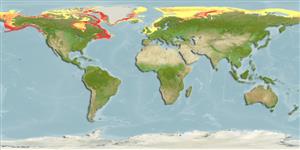Environment: milieu / climate zone / depth range / distribution range
Ekologi
laut dasar (demersal); kisaran kedalaman 0 - 647 m (Ref. 50610), usually 100 - 200 m (Ref. 5951). Polar; 84°N - 43°N, 180°W - 180°E (Ref. 117245)
Arctic, Northwest to Northeast Atlantic, Northeast Pacific: Greenland, Canada, and southeastern Alaska (Ref. 2850).
Size / Weight / umur
Maturity: Lm ? range ? - ? cm
Max length : 52.0 cm TL jantan/; (Ref. 2850)
Occurs among seaweeds or rocks (Ref. 7251). Often found in empty scallop shells (Ref. 7251). Benthic species. Feeds on crustaceans (Ref. 58426), such as amphipods and crabs (Ref. 5951).
Robins, C.R., R.M. Bailey, C.E. Bond, J.R. Brooker, E.A. Lachner, R.N. Lea and W.B. Scott, 1991. Common and scientific names of fishes from the United States and Canada. Am. Fish. Soc. Spec. Publ. (20):183 p. (Ref. 3814)
Status IUCN Red List (Ref. 130435: Version 2024-2)
ancaman kepada manusia
Harmless
penggunaan manusia
Perikanan: tidak ada kepentingan
Alat, peralatan
laporan khas
muat turun XML
Sumber internet
Estimates based on models
Preferred temperature (Ref.
123201): -1.4 - 5.9, mean -0.3 °C (based on 868 cells).
Phylogenetic diversity index (Ref.
82804): PD
50 = 0.5000 [Uniqueness, from 0.5 = low to 2.0 = high].
Bayesian length-weight: a=0.01202 (0.00505 - 0.02860), b=3.05 (2.84 - 3.26), in cm total length, based on LWR estimates for this (Sub)family-body shape (Ref.
93245).
Trophic level (Ref.
69278): 3.7 ±0.3 se; based on diet studies.
Daya lenting (Ref.
120179): sedang, Waktu penggandaan populasi minimum 1.4 - 4.4 tahun (Fec=4,000-12,000).
Fishing Vulnerability (Ref.
59153): Moderate vulnerability (41 of 100).
